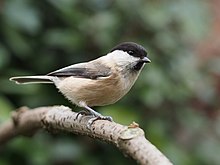
Back قرقف المستنقعات (جنس) Arabic قرقف (جنس من الطيور) ARZ Ciesta (Poecile) AVK Poecile Breton Poecile Catalan Poecile CEB Poecile Czech Poecile Danish Poecile Esperanto Poecile Spanish
| Poecile | |
|---|---|

| |
| Willow tit, Poecile montanus | |
| Scientific classification | |
| Domain: | Eukaryota |
| Kingdom: | Animalia |
| Phylum: | Chordata |
| Class: | Aves |
| Order: | Passeriformes |
| Family: | Paridae |
| Genus: | Poecile Kaup, 1829 |
| Type species | |
| Parus palustris Linnaeus, 1758
| |
| Species | |
|
see text | |
Poecile is a genus of birds in the tit family Paridae. It contains 15 species, which are scattered across North America, Europe and Asia; the North American species are the chickadees. In the past, most authorities retained Poecile as a subgenus within the genus Parus, but treatment as a distinct genus, initiated by the American Ornithologists Union, is now widely accepted.[1] This is supported by mtDNA cytochrome b sequence analysis.[2]
The genus Poecile was erected by the German naturalist Johann Jakob Kaup in 1829.[3] The type species was subsequently designated as the marsh tit (Poecile palustris) by English zoologist George Robert Gray in 1842.[4][5] The name Poecile is from Ancient Greek poikilos "colourful". A related word poikilidos denoted an unidentified small bird.[6] It has traditionally been treated as feminine (giving name endings such as cincta); however, this was not specified by the original genus author Johann Jakob Kaup, and under the ICZN the genus name must therefore be treated by default as masculine, giving name endings such as cinctus.[1]
| ||||||||||||||||||||||||||||||||||||||||||||||||||||||||||||||||||||||||||||||||||||||||||
| Phylogeny of the Poecile based on Tritsch et al. 2017.[7] |
- ^ a b Gosler, A.; Clement, P.; Bonan, A. (2019) [2007]. del Hoyo, J.; Elliott, A.; Sargatal, J.; Christie, D.A.; de Juana, E. (eds.). "Tits and Chickadees (Paridae)". Handbook of the Birds of the World Alive. Lynx Edicions. doi:10.2173/bow.parida1.01. S2CID 216446005. Retrieved 27 August 2019.
- ^ Gill, F.B.; Slikas, B.; Sheldon, F.H. (2005). "Phylogeny of titmice (Paridae): II. Species relationships based on sequences of the mitochondrial cytochrome-b gene". Auk. 122 (1): 121–143. doi:10.1642/0004-8038(2005)122[0121:POTPIS]2.0.CO;2.
- ^ Kaup, Johann Jakob (1829). Skizzirte Entwickelungs-Geschichte und natürliches System der europäischen Thierwelt (in German). Vol. c. 1. Darmstadt: Carl Wilhelm Leske. p. 114.
- ^ Gray (1842). Appendix to a List of the Genera of Birds (2nd ed.). London: R. and J.E. Taylor. p. 8.
- ^ Dickinson, E.C.; Christidis, L., eds. (2014). The Howard & Moore Complete Checklist of the Birds of the World. Vol. 2: Passerines (4th ed.). Eastbourne, UK: Aves Press. p. 428. ISBN 978-0-9568611-2-2.
- ^ Jobling, J.A. (2018). del Hoyo, J.; Elliott, A.; Sargatal, J.; Christie, D.A.; de Juana, E. (eds.). "Key to Scientific Names in Ornithology". Handbook of the Birds of the World Alive. Lynx Edicions. Retrieved 15 May 2018.
- ^ Tritsch, Christian; Martens, Jochen; Sun, Yue-Hua; Heim, Wieland; Strutzenberger, Patrick; Päckert, Martin (2017). "Improved sampling at the subspecies level solves a taxonomic dilemma – A case study of two enigmatic Chinese tit species (Aves, Passeriformes, Paridae, Poecile)". Molecular Phylogenetics and Evolution. 107: 538–550. Bibcode:2017MolPE.107..538T. doi:10.1016/j.ympev.2016.12.014. PMID 27965081.